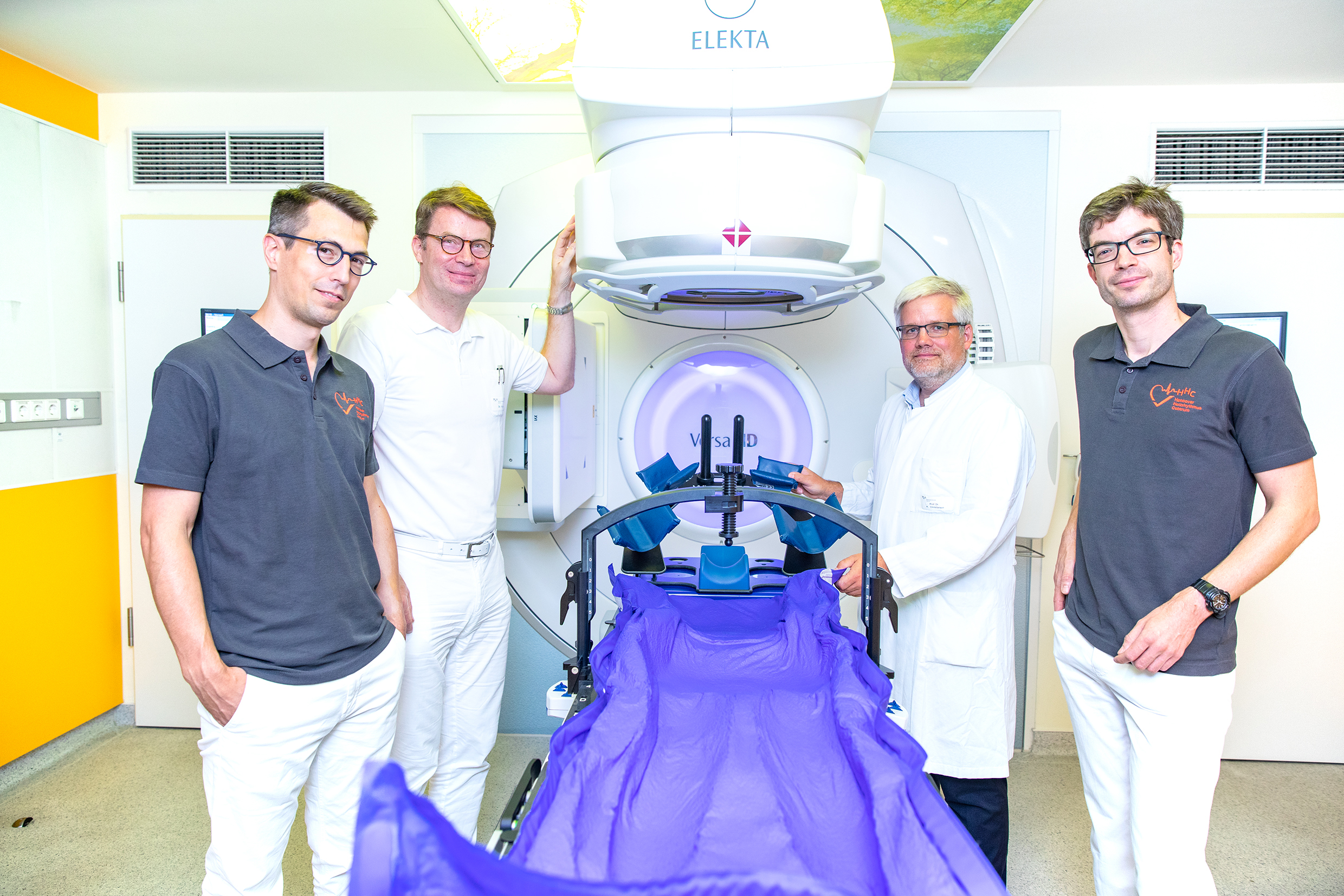Cooperation between radiotherapy and cardiology: MHH experts achieve success with innovative treatment method

Professor Dr. David Duncker, Dr. Roland Merten, Professor Dr. Hans Christiansen and Dr. Stephan Hohmann (from left to right) at the device for high-precision radiation. Copyright: "Karin Kaiser / MHH".
12.10.2022
Radiotherapy - most people think of it as the treatment of cancer. At the Hannover Medical School (MHH), radiation is now being used to help patients with cardiac arrhythmias. High-precision radiation from linear accelerators is used to treat the exact spot in the heart muscle that is responsible for the arrhythmia. The procedure is relatively new and is only carried out in a few clinics in Germany. It is suitable for patients who are very seriously ill and for whom conventional therapy methods are not sufficient. Experts from the Clinic for Radiotherapy and Special Oncology, headed by Professor Dr. Hans Christiansen, and the Clinic for Cardiology and Angiology, headed by Professor Dr. Johann Bauersachs, work closely together on this treatment method.
In Germany, around 400,000 people are admitted to hospital every year because of cardiac arrhythmias. A common form of the disease is the so-called ventricular tachycardia, in which the rhythm disturbances originate from scarred areas in the heart muscle. There are several options for treatment. These include medication, the implantation of a defibrillator, which regulates the heart rhythm by delivering a shock when the heart is in ventricular fibrillation, and catheter ablation. In an ablation, the scarred heart muscle areas are sclerosed via special catheters. "Nevertheless, there are patients who continue to have life-threatening cardiac arrhythmias despite the generally very good treatment options," explains Professor Dr. David Duncker, head of the Hannover Heart Rhythm Centre (HHC) at the Clinic for Cardiology and Angiology.
The defibrillator triggered again and again
One of those affected is Gerd W. Due to heart failure, also called cardiac insufficiency, he has been suffering from cardiac arrhythmias since 2006. "At that time I got bypasses and a defibrillator was implanted. At first everything went well. After a few years, however, the arrhythmias set in noticeably," recalls the 55-year-old from the Hanover region. In 2019 and 2021, he had such severe disturbances that the defibrillator triggered. The incidents, which were physically and psychologically very stressful, happened again and again, so that further medication was added to stabilise the heart rhythm. A little later, the first catheter ablation was performed. But it went on. In September 2021, he experienced the most severe cardiac arrhythmia to date - like a storm, the defibrillator triggered one shock after another to bring the heart back into the right rhythm. Each triggering of the defibrillator brought Gerd W. back to the intensive care unit. "After a second catheter ablation and rehabilitation in the meantime, I thought more and more about high-precision radiation," says Gerd W. After extensive interdisciplinary consultation with Dr. Roland Merten, senior physician at the Clinic for Radiation Therapy and Special Oncology and the specialists at the Hannover Heart Rhythm Centre at the Clinic for Cardiology and Angiology, he decided to have the procedure applied.
"With catheter ablation, not all areas of the heart muscle can be reached. That's where high-precision radiation can show its advantages," explains Dr Stephan Hohmann, Senior Physician Rhythmology at the Hannover Heart Rhythm Centre. High-precision radiation with the help of a linear accelerator has so far been known mainly for the treatment of tumours, for example brain metastases. "We can deliver the high-energy radiation to the desired target point with millimetre precision. This maximises the effect on the diseased tissue and spares the surrounding tissue," explains Professor Dr Hans Christiansen, Director of the Clinic for Radiotherapy and Special Oncology. In high-precision radiation against cardiac arrhythmias, the radiation hits precisely the scarred areas of heart muscle responsible for the disorders and causes the tissue to remodel. The radiation can hit the area from many different angles and in varying doses. Although the image-guided intervention takes only a few minutes, it must be prepared in the Clinic for Radiotherapy on the basis of the 3-D image data from the rhythmological cather examination. A medical physicist needs about a day to construct a 3-D model on the computer, with the help of which the radiation reaches exactly the desired target. And the medical-technical assistants have to place the patients with millimetre precision.
All patients benefit from procedures
High-precision radiation against cardiac arrhythmias is a unique and painless procedure. "Since it is a non-invasive procedure, unlike catheter ablation, it is also suitable for patients who are too ill for an invasive procedure," Professor Duncker notes. The cardiologists and radiotherapists at the MHH have used the new treatment procedure interdisciplinarily on five patients so far, making it one of the most experienced centres in Europe. "Everyone has benefited from it. Even if the arrhythmias did not always disappear completely, the frequency and severity could be significantly reduced. That is a huge gain for those affected," explains Professor Duncker.
SERVICE:
For more information, contact Professor Dr Roland Merten, Clinic for Radiotherapy and Special Oncology, merten.roland@mh-hannover.de, phone (0511) 532-3590 and Professor Dr David Duncker, Hannover Heart Rhythm Centre, Clinic for Cardiology and Angiology, duncker.david@mh-hannover.de, phone (0511) 532-82604.